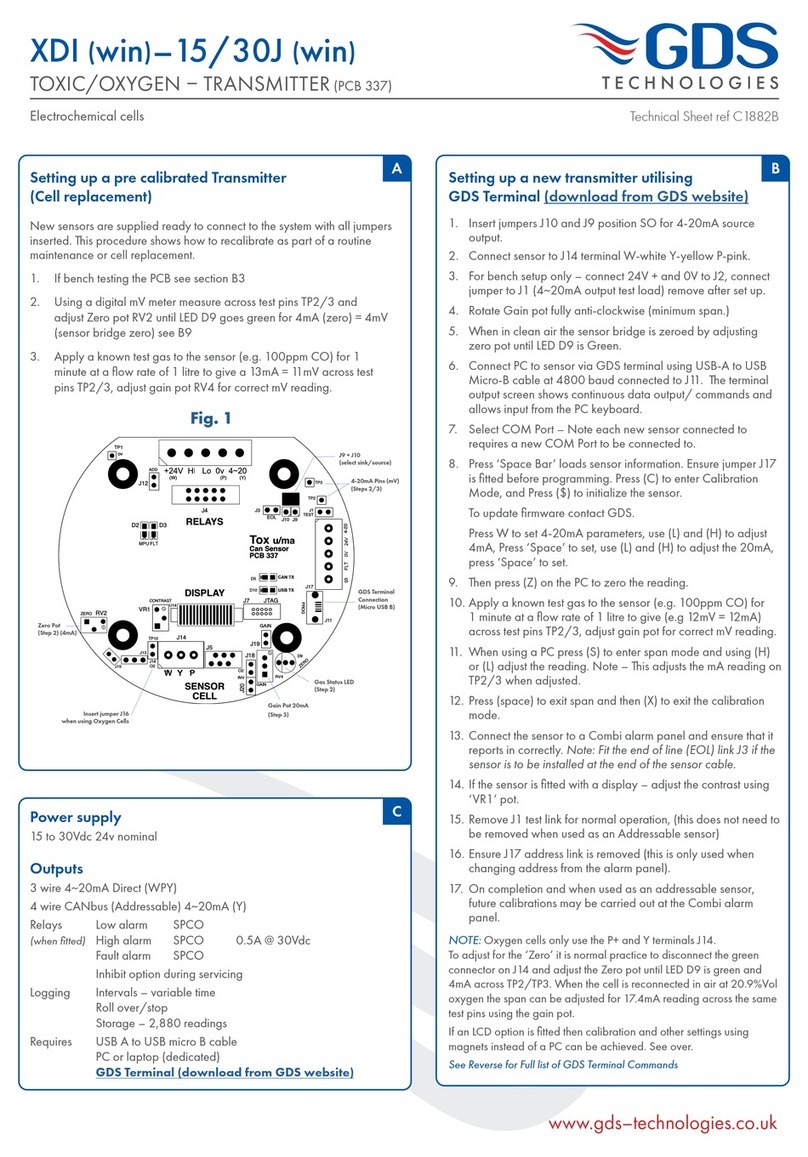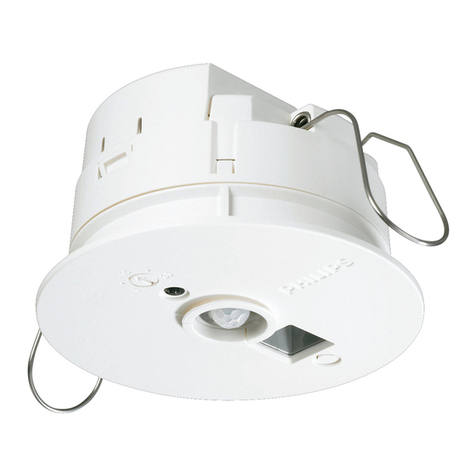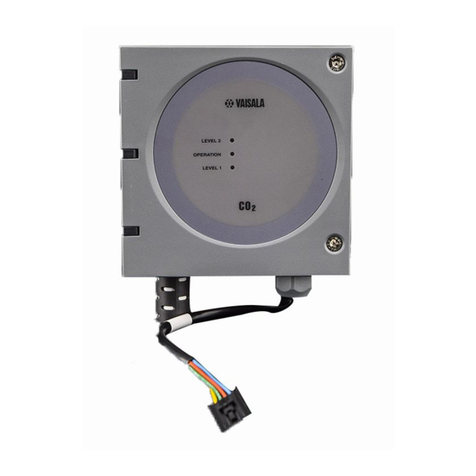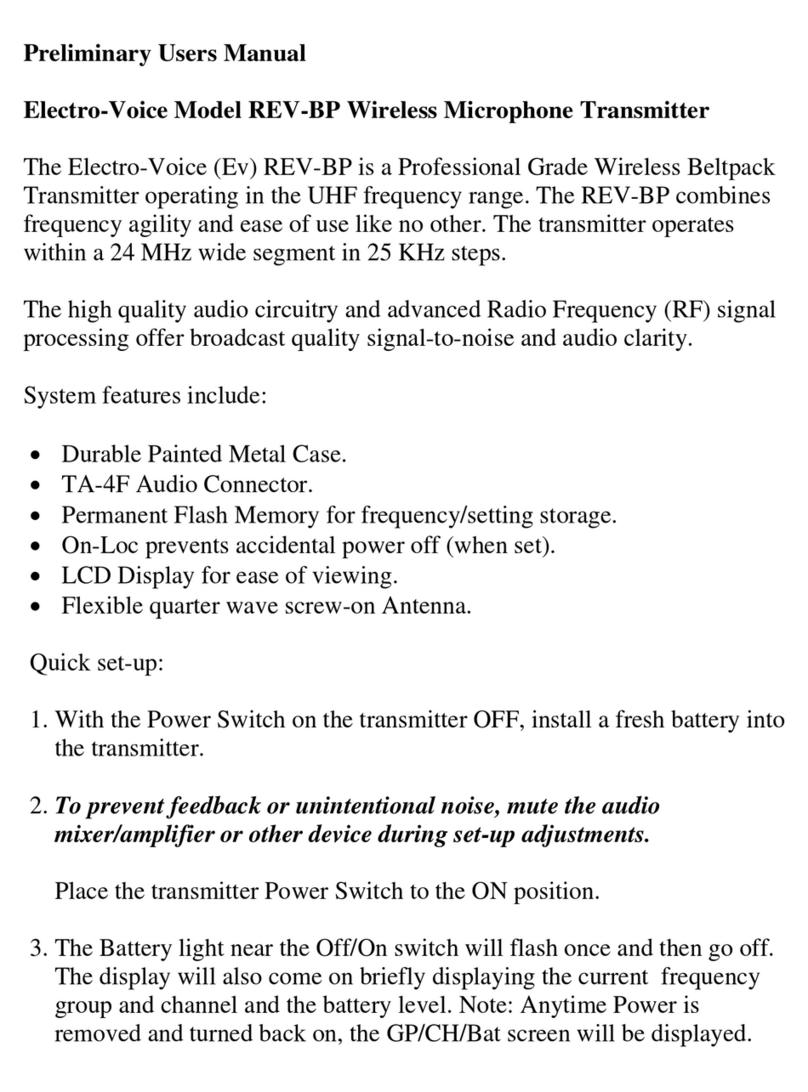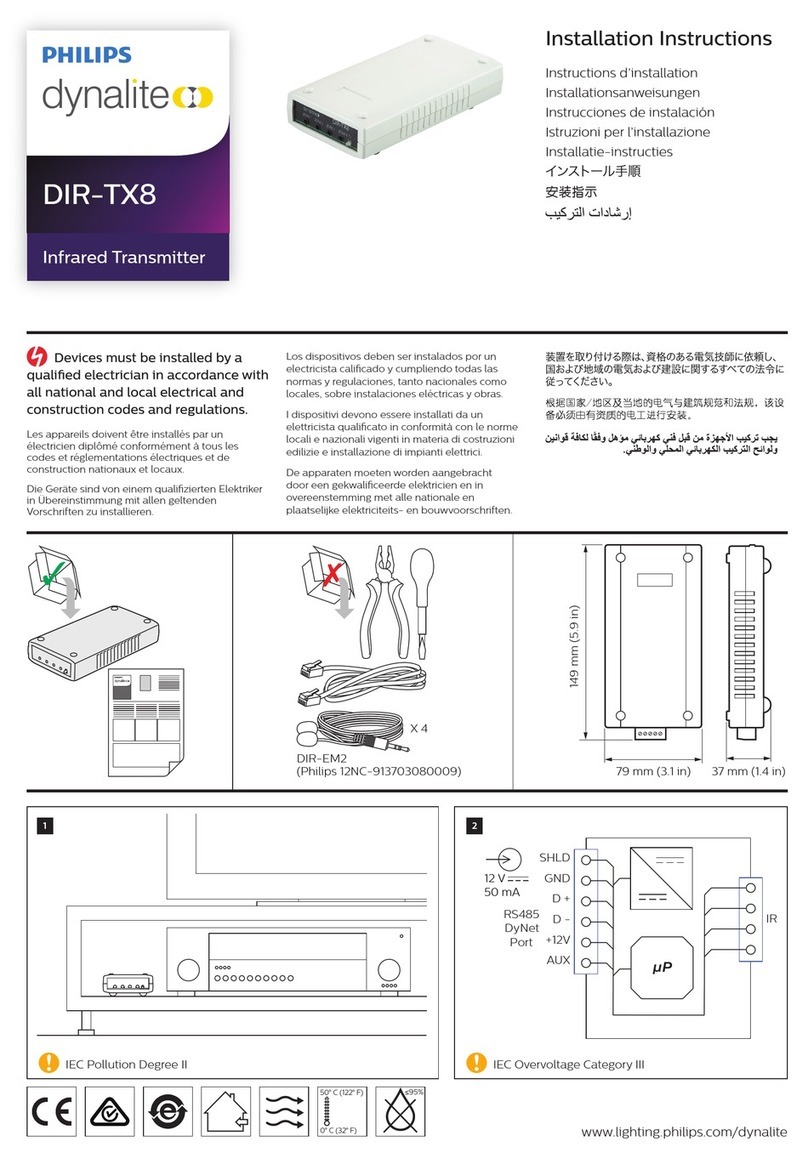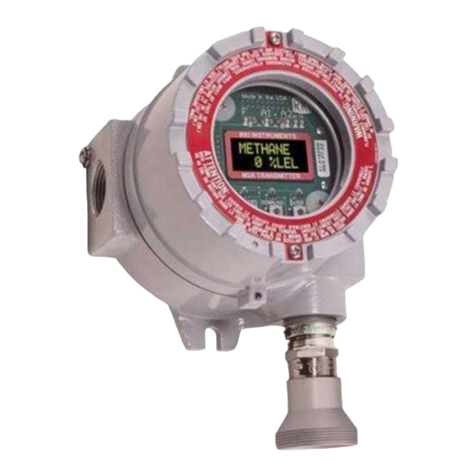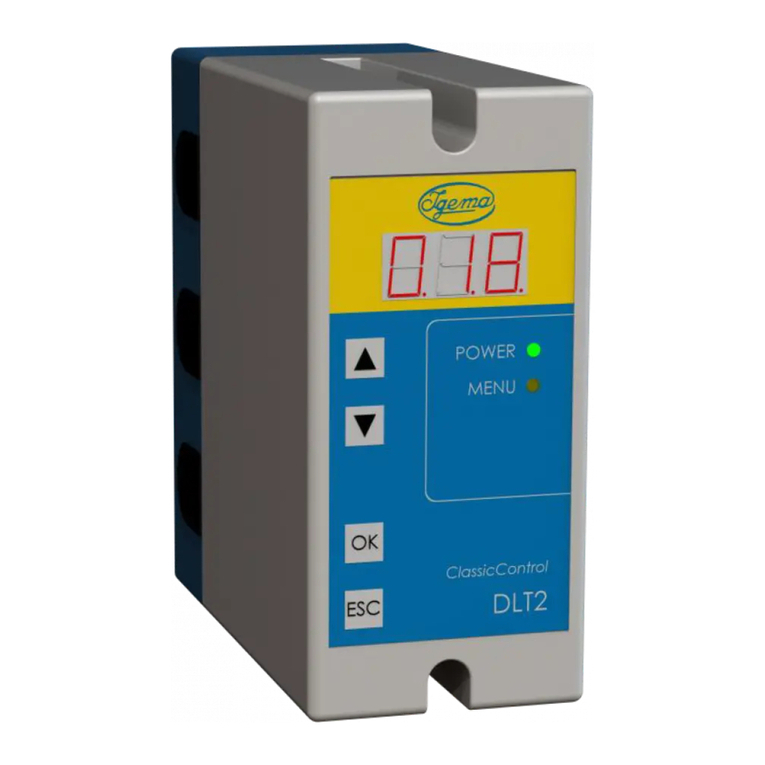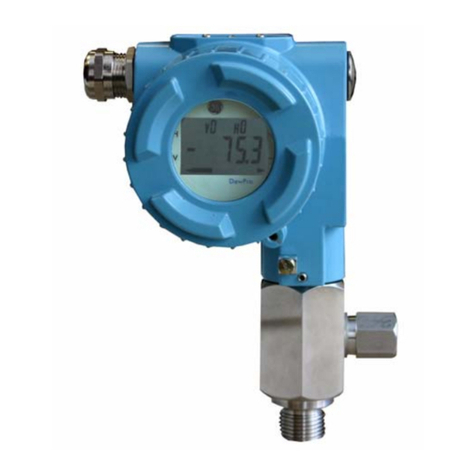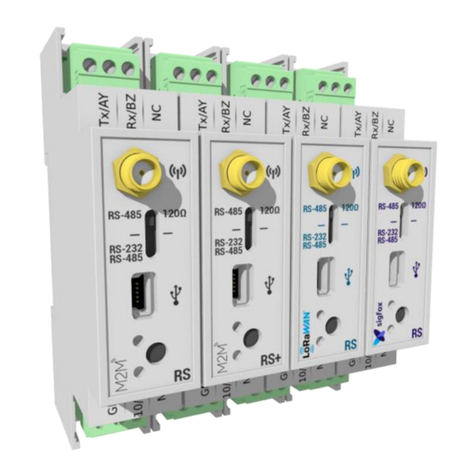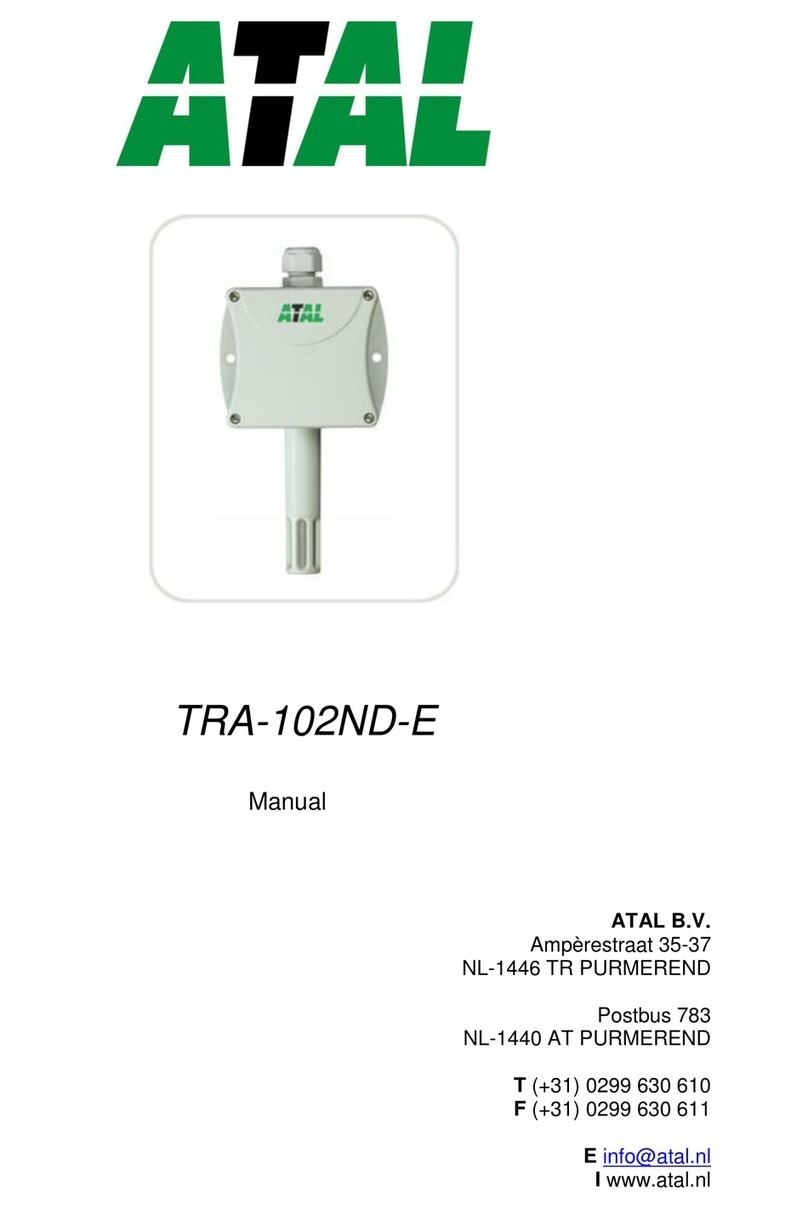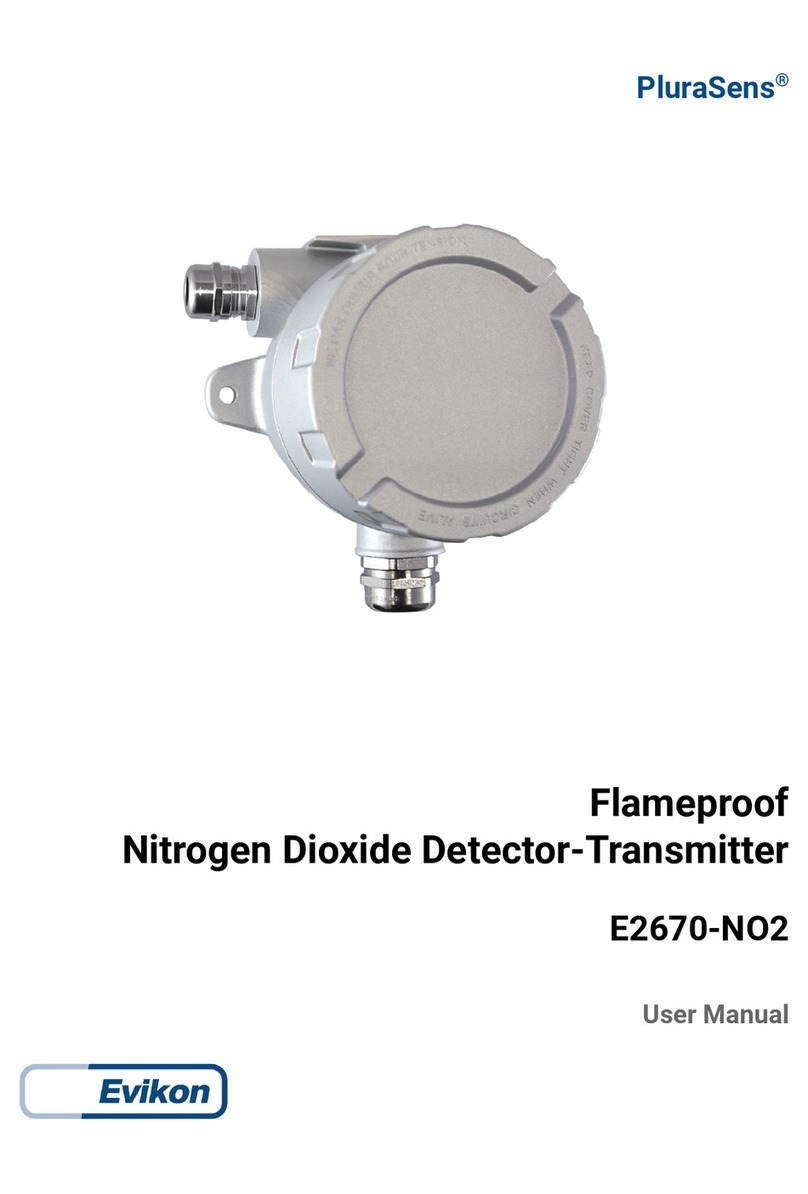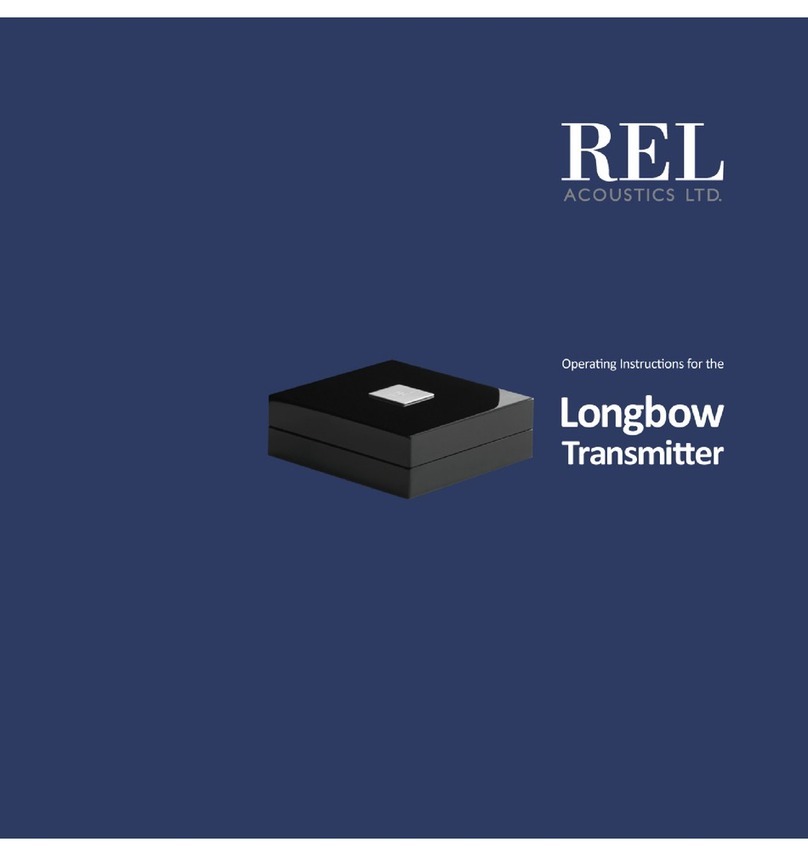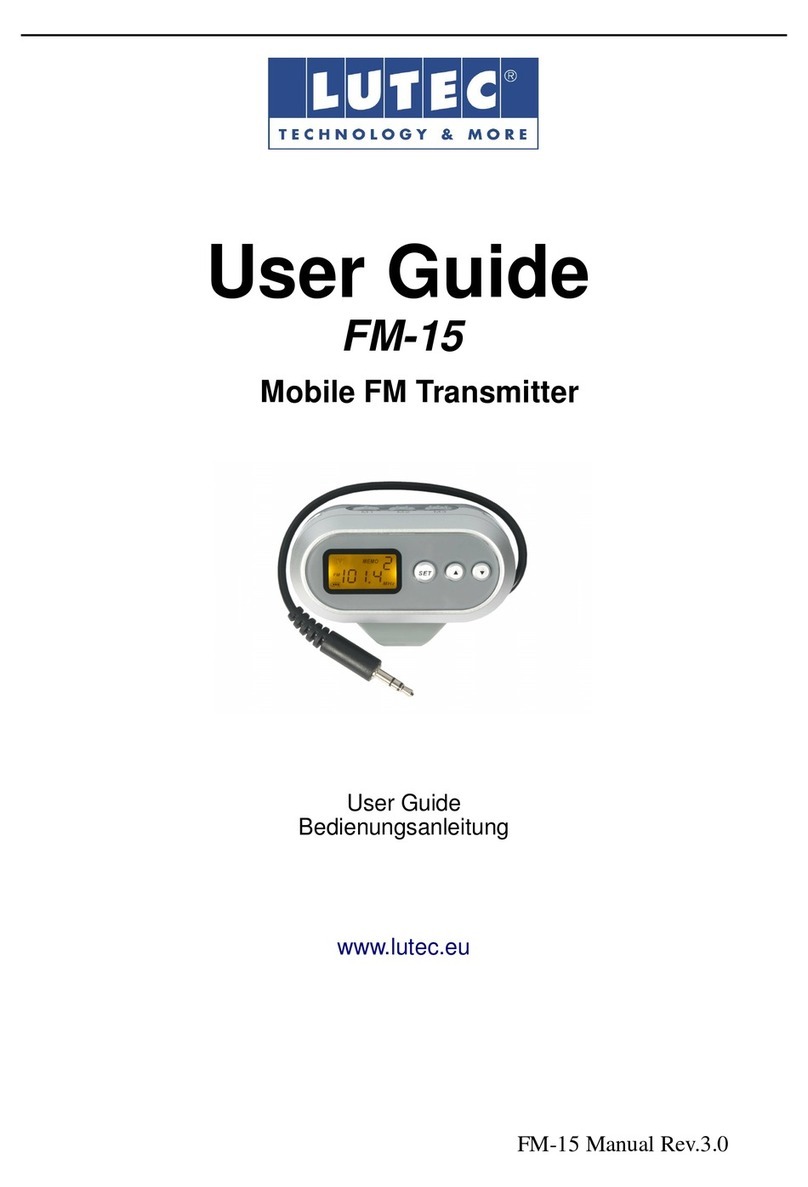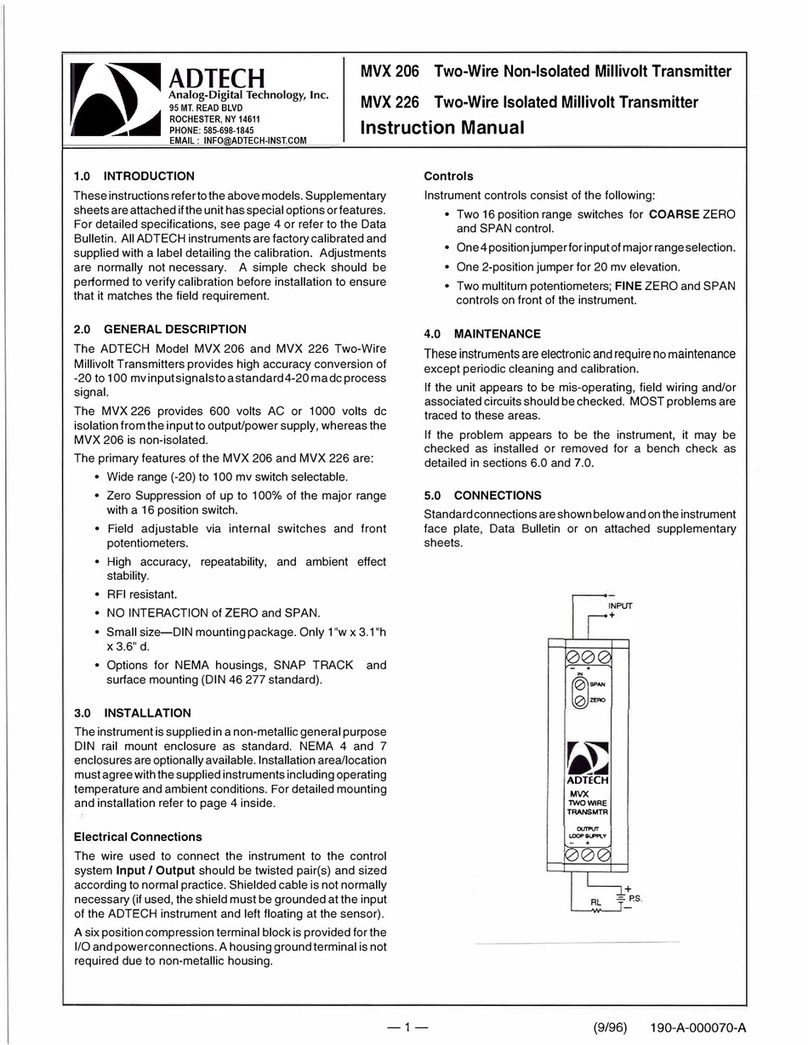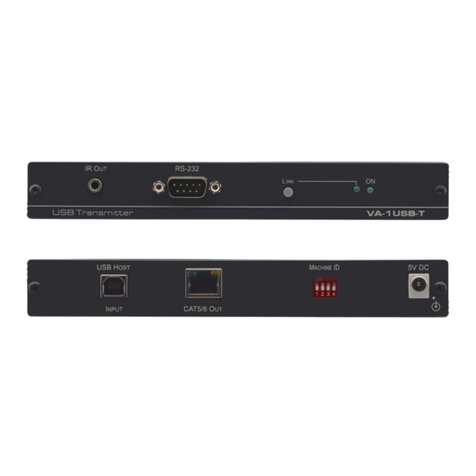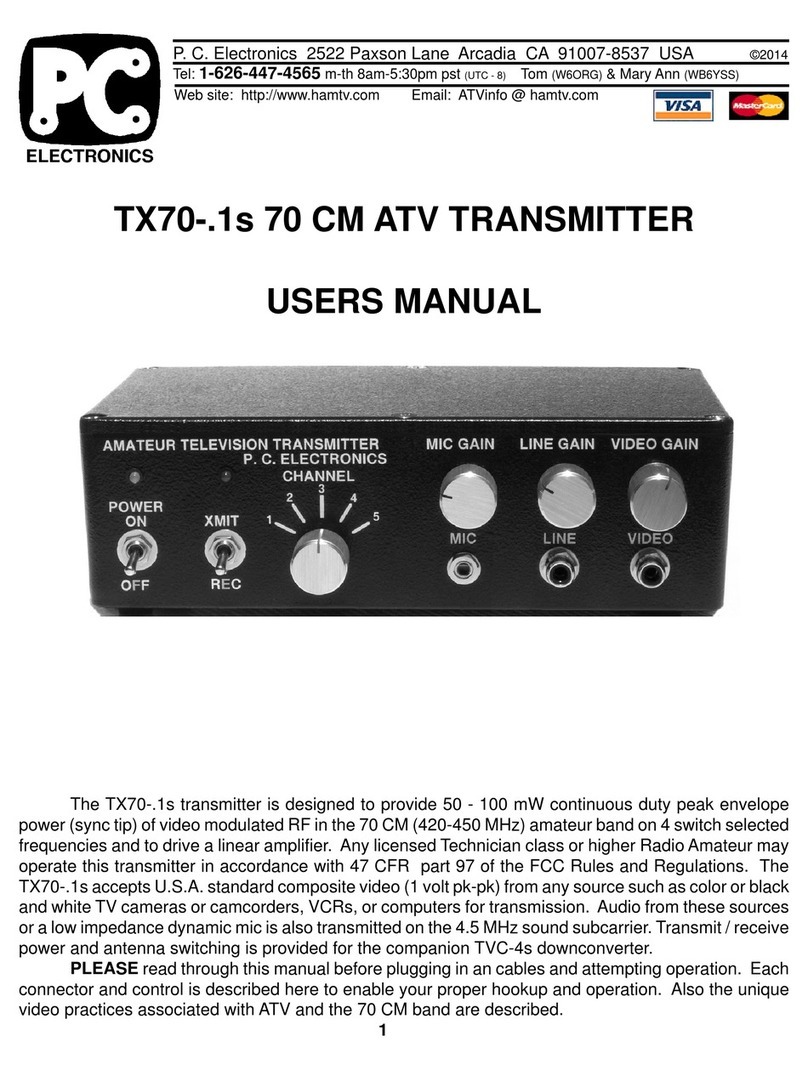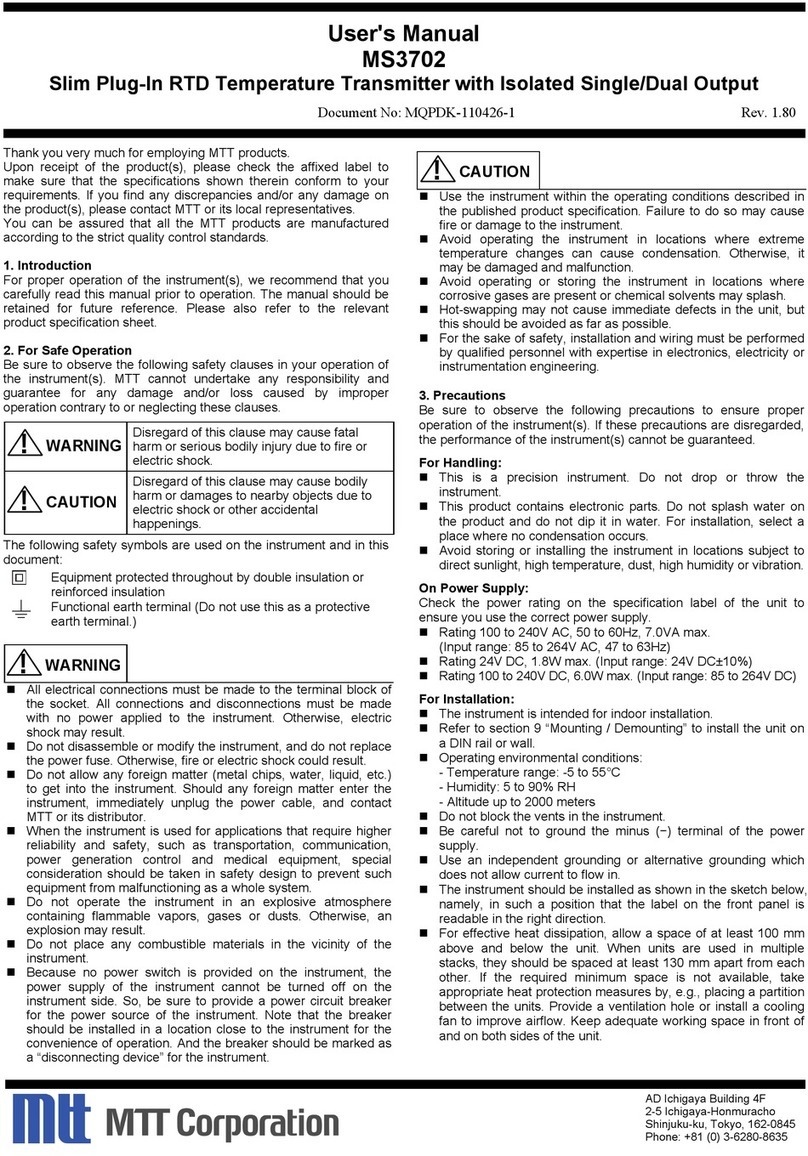Micrel MICRF405 User manual

MICRF405
290MHz – 980MHz ISM Band
ASK / FSK Transmitter
MicroLead Frame and MLF are registered trademarks of Amkor Technologies
RadioWire is a registered trademark of Micrel, Inc.
Micrel Inc. • 2180 Fortune Drive • San Jose, CA 95131 • USA • tel +1 (408) 944-0800 • fax + 1 (408) 474-1000 • http://www.micrel.com
April 2006 M9999-041906
(408) 955-1690
General Description
The MICRF405 is a 290MHz-980MHz RF transmitter
IC designed for unlicensed ISM band operations. It's
designed to work in the North American 315MHz
and 915MHz bands as well as the European
433MHz and 868MHz bands. The device is fully
FCC Part 15.247 and EN300-220-compliant.
The transmitter consists of a FSK/ASK modulator,
PLL frequency synthesizer and a power amplifier.
The frequency synthesizer consists of a voltage-
controlled oscillator (VCO), a crystal oscillator, dual
modulus prescaler, programmable frequency
dividers and a phase-detector. The loop-filter can be
internal or external. The output power of the power
amplifier can be programmed to eight levels. A lock
detect circuit detects when the PLL is in lock.
In FSK mode, the user can select between three
different modulation types allowing a data rate up to
200kbps. When selecting FSK modulation applied
with dividers, the MICRF405 is switching between to
sets of register values (M0,N0,A0:"0" and M1,N1
and A1:"1"). The second modulation type is closed
loop VCO modulation using the internal modulator
that applies the modulated data to the VCO. The
third FSK modulation type is Open loop VCO
modulation.
In ASK modulation, the user can select between two
modulation types, with or without spreading. In both
modes the modulation depth is programmable.
RadioWire®
Features
•FSK/ASK transmitter
•Frequency programmable
•ASK modulation depth programmable
•High efficiency power amplifier
•Programmable output power
•Power down function
•MCU reference clock
•Base band package engine
•TX buffer
•No external tuning circuitry
Applications
•Meter reading
•Automotive
•Smart Home
•Remote control systems
•Residential Automation
•Wireless security system

Micrel MICRF405
April 2006 2 M9999-041906
(408) 955-1690
Table of Contents
General Description ................................................................................................................................................................... 1
Features..................................................................................................................................................................................... 1
Applications................................................................................................................................................................................ 1
Table of Contents....................................................................................................................................................................... 2
Ordering Information .................................................................................................................................................................. 3
Block Diagram............................................................................................................................................................................ 3
Pin Configuration........................................................................................................................................................................ 4
Absolute Maximum Ratings(1)..................................................................................................................................................... 5
Operating Ratings(2) ................................................................................................................................................................... 5
Electrical Characteristics............................................................................................................................................................ 5
Electrical Characteristics (cont.)................................................................................................................................................. 6
Data and Configuration Interface ............................................................................................................................................... 7
Programming Interface Timing .............................................................................................................................................. 8
Writing to the Control Registers in MICRF405....................................................................................................................... 9
What to write: ........................................................................................................................................................................ 9
How to write:.......................................................................................................................................................................... 9
The two different ways to “program the chip” are: ................................................................................................................. 9
Writing to a Single Register................................................................................................................................................... 9
How to write:.......................................................................................................................................................................... 9
Writing to All Registers ........................................................................................................................................................ 10
What to write ....................................................................................................................................................................... 10
How to write:........................................................................................................................................................................ 10
Writing to n Registers Having Incremental Addresses......................................................................................................... 10
What to write ....................................................................................................................................................................... 11
Writing to n Registers Having Non-Incremental Addresses................................................................................................. 12
Reading from the Control Registers in MICRF405 .............................................................................................................. 12
Reading from the Interrupt Register .................................................................................................................................... 12
Data Interface and Data Transfer............................................................................................................................................. 13
Packet Engine Overview: .................................................................................................................................................... 14
How to transmit a Packet with the Packet Engine: .............................................................................................................. 15
Programming Summary....................................................................................................................................................... 17
Main Modes of Operation......................................................................................................................................................... 18
Power Amplifier ........................................................................................................................................................................ 18
Frequency Synthesizer............................................................................................................................................................. 19
Crystal Oscillator (XCO)........................................................................................................................................................... 21
VCO ......................................................................................................................................................................................... 22
Charge Pump and PLL Filter.................................................................................................................................................... 24
Modulation................................................................................................................................................................................ 27
Bit rate settings.................................................................................................................................................................... 30
Modulator ............................................................................................................................................................................ 30
Deviation setting.................................................................................................................................................................. 31
Shaping ............................................................................................................................................................................... 31
Modulator saturation............................................................................................................................................................ 31
Lock Detect ......................................................................................................................................................................... 32
Low Dropout Regulator (LDO) and Low Battery Detector.................................................................................................... 33
Bit Description .......................................................................................................................................................................... 34
Typical Application Circuit ........................................................................................................................................................ 42
Package Information ................................................................................................................................................................ 45

Micrel MICRF405
April 2006 3 M9999-041906
(408) 955-1690
Ordering Information
Part Number Junction Temp. Range(1) Package
MICRF405YML –40° to +125°C PB-Free 24-Pin MLF®
____________________________________________________________________________________________________
Block Diagram

Micrel MICRF405
April 2006 4 M9999-041906
(408) 955-1690
Pin Configuration
24-Pin MLF®(Top View)
Pin Number Pin Name Type Pin Function
1 VDD VDD
2 RFGND RF Ground
3 RFVDD RF VDD
4 RFOUT O RF output
5 RFGND RF Ground
6 NC Not connected
7 XTB O Crystal oscillator output
8 XTA I Crystal oscillator input
9 DVDD Digital VDD
10 DGND Digital ground
11 VDD VDD
12 LD O Lock Detect output
13 CLKOUT O Programmable Clock output
14 RDY/DATACLK O Transmit buffer Ready / Alternative Data clock
15 DATAIN I Alternative Data input
16 SCK I SPI clock
17 SIO I/O Serial input/output
18 SEN I Serial programming interface enable
19 SRV O Service interrupt pin
20 CPOUT O Charge pump output
21 VARIN I VCO varactor input
22 AGND Analog ground
23 AVDD Analog VDD
24 CIBIAS O Bias
25 HEATSINK Ground

Micrel MICRF405
April 2006 5 M9999-041906
(408) 955-1690
Absolute Maximum Ratings(1)
Supply Voltage (VDD)......................................... +3.7V
Voltage on any pin(3) (GND = 0V)... -0.3V to 3.7V
Lead Temperature (soldering, 20sec.)............. 260°C
Storage Temperature (Ts) ................ -55°C to +150°C
ESD Rating(4)
All pins except pin 4...................................... 2 kV
Pin 4 (RFOUT)............................................ 200 V
Operating Ratings(2)
Supply voltage (VIN)............................ +2.2V to +3.6V
RF Frequencies.......................... 290MHz to 980MHz
Data Rate (NRZ) ...........................................200kbps
Ambient Temperature (TA) .............. –40°C to +125°C
Package Thermal Resistance
MLF® (ΘJA) ............................................41.7°C/W
Electrical Characteristics
fRF = 915MHz. VDD = 3.0V; TA= 25°C, bold values indicate –40°C< TA< +125°C, unless noted.
Parameter Condition Min Typ Max Units
Freq_band=0 290 325 MHz
Freq_band=1 430 490 MHz
RF Frequency Operating Range
Freq_band=2-3 860 980 MHz
Power Supply 2.2 3.6 V
Power Down Current 0.3
µA
Standby Current ClkOut_en=0 200
µA
PLL mode current PA2-0=000, PA off 5.6 mA
VCO and PLL Section
Reference Frequency 4 40
MHz
1kHz loop filter bandwidth, Fphd=200kHz 7.0 ms
3kHz loop filter bandwidth, Fphd=500kHz 1.8 ms
PLL startup
30kHz loop filter bandwidth,
Fphd=1000kHz
140 µs
Standby-TX (PA on)
30kHz bandwidth
200
µs
Crystal Oscillator Start-Up Time 16MHz, 9pF load, XCO_Fast=1 300 µs
Charge Pump Current VCPOUT = 1.2V, CP_CUR = 3 100 µA
Transmit Section
RLOAD = 250Ω, Pa2-0=111 10 dBm
Output Power
RLOAD = 250Ω, Pa2-0=001 -7 dBm
Over temperature range 1.5 dB
Output Power Tolerance Over power supply range 3.0 dB
RLOAD = 150Ω, PA2-0=111 18 mA
RLOAD = 150Ω, PA2-0=001 9.6 mATx Current Consumption
RLOAD = 150Ω, PA2-0=000 5.6 mA
ASK=7 (OOK) 60 dB
Modulation depth ASK/OOK ASK=6 20 dB
Binary FSK Frequency Deviation(5) Bitrate = 200kbps 300
kHz
VCO modulation 20 200
kbps
Divider modulation 20
kbps
Data Rate(5)
ASK 50
kbps

Micrel MICRF405
April 2006 6 M9999-041906
(408) 955-1690
Electrical Characteristics (cont.)
Parameter Condition Min Typ Max Units
FSK 38.4kbps, β= 2, bandwidth for 99.5%
of total power, RBW=10kHz
130 kHz
FSK 125kbps, β= 2, bandwidth for 99.5%
of total power, RBW=30kHz
425 kHz
FSK 200kbps, β= 2, bandwidth for 99.5%
of total power, RBW=100kHz
750 kHz
Occupied bandwidth
ASK (OOK) 38.4kbps, bandwidth for 99.5%
of total power, RBW=10kHz
200 kHz
ASK 20dB modulation depth, 38.4kbps,
bandwidth for 99% of total power,
RBW=10kHz
120 kHz
2nd Harmonic -36 dBm
3rd Harmonic -54 dBm
Spurious Emission<1GHz -54 dBm
Spurious Emission>1GHz -41 dBm
LO Leakage
Measured with matching network
-80 dBm
Notes:
1. Exceeding the absolute maximum rating may damage the device.
2. The device is not guaranteed to function outside its operating rating.
3. On the pins RFVDD (3), PTATBIAS (6), DVDD (9), CPOUT (20), VARIN (21) and AVDD (23), the maximum input voltage should not
exceed 2.75V.
4. Devices are ESD sensitive. Handling precautions recommended. Pin 4, RFOUT, has less ESD protection (Human body model (HBM) of
200V and Charged Device Model (CDM) of 500V).
5. Guaranteed by design.

Micrel MICRF405
April 2006 7 M9999-041906
(408) 955-1690
Data and Configuration Interface
The user interface of the MICRF405 is a serial
peripheral interface (SPI) consisting of Serial
interface enable (SEN), Serial data input/output
(SIO) and Serial clock (SCK). This user interface is
used for MICRF405 configuration setup and can
also be used for sending the user data. A second
option is to transmit data bitwise using the DATAIN
pin. The RDY/DATACLK pin is used to synchronize
the data transfers.
The control word consists of 30 addressable bytes
and defines the way of operations as well as
transmitting data. Table 1 shows all 30 bytes. The
values specified are the default setup, which are
preset after power up. The first register is the
desktop register controlling the state of the 405, the
PA and clock-out for the microcontroller. The next
block of 10bytes sets the output radio frequency
through the dividers A, N and M. The bytes with
address 11 to 21 set the frequency band, modulation
type, bit rate, loop filter type and bandwidth, XCO
tuning etc. This block is not frequently used as these
settings are usually static application dependent.
Address 22 and 23 are mostly test bits, and are
seldom altered from default settings in applications.
The interrupt register, which is located at address
24, is read only (writing to it will not do any harm or
have any effect). The last 5 bytes are used when
transferring user data to transmit through the SPI.
The first four set the SyncID field in the packet, and
the last is the one byte data buffer.
Adr Data
A6..A0 D7 D6 D5 D4 D3 D2 D1 D0
0000000 Mode1=0 Mode0=1 PA2=1 PA1=1 PA0=1 ClkOut_en=1 Sync_en=1 Load_en=1
0000001 - - A0_5=0 A0_4=0 A0_3=1 A0_2=1 A0_1=1 A0_0=0
0000010 - - - - N0_11=0 N0_10=0 N0_9=0 N0_8=0
0000011 N0_7=0 N0_6=1 N0_5=1 N0_4=1 N0_3=0 N0_2=0 N0_1=1 N0_0=1
0000100 - - - - M0_11=0 M0_10=0 M0_9=0 M0_8=0
0000101 M0_7=0 M0_6=0 M0_5=1 M0_4=0 M0_3=0 M0_2=0 M0_1=0 M0_0=1
0000110 - - A1_5=0 A1_4=1 A1_3=1 A1_2=1 A1_1=1 A1_0=1
0000111 - - - - N1_11=0 N1_10=0 N1_9=0 N1_8=0
0001000 N1_7=0 N1_6=1 N1_5=1 N1_4=0 N1_3=1 N1_2=1 N1_1=1 N1_0=1
0001001 - - - - M1_11=0 M1_10=0 M1_9=0 M1_8=0
0001010 M1_7=0 M1_6=0 M1_5=1 M1_4=0 M1_3=0 M1_2=0 M1_1=0 M1_0=0
0001011 LowBatt_en=1 Freq_Band1=0 Freq_Band0=1 VCO_freq2=0 VCO_freq1=1 VCO_freq0=1 Modulation1=1 Modulation0=0
0001100 LowBatt_level=0 LDO_by=0 LDO_en1=1 LDO_en0=1 MOD_LDc_en=0 PA_FEc_en=0 PA_LDc_en=0 LD_en=1
0001101 Bit_IO_en=1 Manchester_en=0 Sel_CRC1=1 Sel_CRC0=1 SyncID_Len1=0 SyncID_Len0=1 Pream_Len1=1 Pream_Len0=0
0001110 Mod_I4=0 Mod_I3=1 Mod_I2=0 Mod_I1=0 Mod_I0=1 Mod_A2=0 Mod_A1=1 Mod_A0=1
0001111 VCO_Fr_Chk=0 VCO_Fr_Auto=0 FSKn2=1 FSKn1=0 FSKn0=0 Mod_F2=1 Mod_F1=0 Mod_F0=0
0010000 0 Prescaler_Sel=0 FSKClk_K5=1 FSKClk_K4=1 FSKClk_K3=0 FSKClk_K2=1 FSKClk_K1=0 FSKClk_K0=0
0010001 ASK_PN_en=0 ASK_EN=0 ASKshape2=1 ASKshape1=1 ASKshape0=1 ASK2=1 ASK1=1 ASK0=1
0010010 ASKn1=1 ASKn0=0 ASKClk_K5=1 ASKClk_K4=1 ASKClk_K3=0 ASKClk_K2=1 ASKClk_K1=0 ASKClk_K0=0
0010011 INT_LF_EN=1 CP_CUR1=0 CP_CUR0=1 LF_RES1_4=0 LF_RES1_3=1 LF_RES1_2=0 LF_RES1_1=0 LF_RES1_0=1
0010100 LF_High_PM=1 LF_CAP1=1 LF_CAP0=1 LF_RES3_4=0 LF_RES3_3=0 LF_RES3_2=1 LF_RES3_1=0 LF_RES3_0=1
0010101 ClkOut_1=0 ClkOut_0=0 XCO_Fast=1 XCOtune4=1 XCOtune3=0 XCOtune2=0 XCOtune1=0 XCOtune0=0
0010110 INT_LF_TEST=0 VCO_IB2=0 VCO_IB1=0 VCO_IB0=0 VCO_by=0 OUTS2=0 OUTS1=0 OUTS0=0
0010111 PA_IB3=1 PA_IB2 =0 PA_IB1=0 PA_IB0=1 PAB_IB3=1 PAB_IB2=0 PAB_IB1=0 PAB_IB0=1
0011000 VCO_freq_O2 VCO_freq_O1 VCO_freq_O0 VC_HI VC_LO LOW_BATT
0011001 SyncID3_7=1 SyncID3_6=1 SyncID3_5=1 SyncID3_4=0 SyncID3_3=0 SyncID3_2=1 SyncID3_1=0 SyncID3_0=1
0011010 SyncID2_7=1 SyncID2_6=1 SyncID2_5=1 SyncID2_4=0 SyncID2_3=0 SyncID2_2=1 SyncID2_1=0 SyncID2_0=1
0011011 SyncID1_7=1 SyncID1_6=1 SyncID1_5=1 SyncID1_4=0 SyncID1_3=0 SyncID1_2=1 SyncID1_1=0 SyncID1_0=1
0011100 SyncID0_7=1 SyncID0_6=1 SyncID0_5=1 SyncID0_4=0 SyncID0_3=0 SyncID0_2=1 SyncID0_1=0 SyncID0_0=1
0011101 DATA_7 DATA_6 DATA_5 DATA_4 DATA_3 DATA_2 DATA_1 DATA_0
Table 1. Controlword MICRF405 (values preset at power-up).

Micrel MICRF405
April 2006 8 M9999-041906
(408) 955-1690
Programming Interface Timing
Figure 1 and Table 2 shows the timing specification
for the 3-wire serial programming interface.
Figure 1. Programming Interface Timing.
Values
Symbol
Parameter Min. Typ. Max.
Units
Tper Min. period of SCK 50 ns
Thigh Min. high time of SCK 20 ns
Tlow Min. low time of SCK 20 ns
Tfall Max. time of falling edge of SCK 1 µs
Trise Max. time of rising edge of SCK 1 µs
Tsenf Min. time of falling edge of SEN to falling edge of SCK 0 ns
Tsenr Min. delay from rising edge of SEN to rising edge of SCK 5 ns
Twrite Min. delay from valid SIO to falling edge of SCK during a
write operation 0 ns
Tread Min. delay from rising edge of SCK to valid SIO during a read
operation (assuming load capacitance of SIO is 25pF) 75 ns
Trdy Min. delay from falling edge of SCK (last bit of byte into data
buffer) to falling edge of RDY 20 ns
Thigh Min. duration of a SEN high pulse
(Fphd is the phase detector frequency) 1/Fphd
Time from power up to first falling edge of SEN 3.5 ms
Table 2. Timing Specification for the 3-wire Programming Interface.

Micrel MICRF405
April 2006 9 M9999-041906
(408) 955-1690
Writing to the Control Registers in MICRF405
Writing: A number of octets are entered into
MICRF405 followed by a load-signal to activate the
new setting. Making these events is referred to as a
“write sequence.” It is possible to update all, 1, or n
control registers in a write sequence. The address to
write to (or the first address to write to) can be any
valid address (0-29). The SIO line is always an input
to the MICRF405 (output from user) when writing.
What to write:
•The address of the control register to write to (or
if more than 1 control register should be written
to, the address of the 1st control register to write
to).
•A bit to enable reading or writing of the control
registers. This bit is called the R/W bit.
•The values to write into the control register(s).
Field Comments
Address: A 7-bit field, ranging from 0 to 29. MSB is written first.
R/W bit: A 1-bit field, = “0” for writing
Values: A number of octets (1-30 octets). MSB in every octet is written first. The first octet is written to the control
register with the specified address (=”Address”). The next octet (if there is one) is written to the control
register with address = “Address + 1” and so on.
Table 3. Writing to the Control Registers.
How to write:
Bring SEN low to start a write sequence. The active
state of the SEN line is “low”. Use the SCK/SIO
serial interface to clock in “Address” and “R/W” bit
and “Values” into the MICRF405. MICRF405 will
sample the SIO line at negative edges of SCK. Make
sure to change the state of the SIO line before the
negative edge, for instance on positive edge. Refer
to Figure 2.
Bring SEN inactive to make an internal load-signal
and complete the write-sequence. Note: there is an
exception to this point. If the programming bit called
“load_en” (D0 in ControlRegister0) is “0”, then no
load pulse is generated.
The two different ways to “program the chip”
are:
•Write to a number of control registers (0-29)
when the registers have incremental addresses
(write to 1, all or n registers)
•Write to a number of control registers when the
registers have non-incremental addresses.
Writing to a Single Register
Writing to a control register with address “A6, A5,
…A0” is described here. During operation, writing to
1 register is sufficient to change the way the
transmitter works. Typical example: Change from
transmit mode to power-down.
Field Comments
Address: 7 bit = A6, A5, …A0 (A6 = MSB. A0 = LSB)
R/W bit: “0” for writing
Values: 8 bits = D7, D6, …D0 (D7 = MSB, D0 = LSB)
Table 4. When writing to a Single Register, totally 2 octets are clocked into the MICRF405.
How to write:
•Bring SEN low
•Use SCK and SIO to clock in the 2 octets
•Bring SEN high

Micrel MICRF405
April 2006 10 M9999-041906
(408) 955-1690
SEN
SIO
SCK
Register address Data to write
into register
Internal load pulse
generated here
A6 A5 A4 A3 A2 A1 A0 R/W D7 D6D5 D4 D3 D2 D1 D0
Figure 2. Writing to One Address.
In Figure 2, SIO is changed at positive edges of
SCK. The MICRF405 samples the SIO line at
negative edges. The value of the R/W bits is always
“0” for writing.
Writing to All Registers
Writing to all register can be done at any time. To
get the simplest firmware, always write to all
registers. The price to pay for the simplicity is
increased write-time, which leads to increased time
to change the way the MICRF405 works. If data is
transferred through DATAIN pin write address 0-23
(address 24-29 is don’t care). If data is transferred
through SPI write address 0-28 (Address 29 is only
written to during data transfer, not during
configuration).
What to write
Field Comments
Address: ‘0000000’ (address of the first register to write to, which is 0)
R/W bit: “0” for writing
Values: 1st Octet: wanted values for ControlRegister0. 2nd Octet: wanted values for ControlRegister1 and
so on for all of the octets.
Table 5. When writing to All Registers, totally 25/30 (5 are optional) octets are clocked into the MICRF405.
How to write:
•Bring SEN low
•Use SCK and SIO to clock in the 25/30 octets
•Bring SEN high
Refer to Figure 3. Writing to n Registers Having
Incremental Addresses.
Writing to n Registers Having Incremental
Addresses
In addition to entering all bytes, it is also possible to
enter a set of n bytes, starting from address i = “A6,
A5, … A0”. Typical example: Clock in a new set of
frequency dividers (i.e. change the RF frequency).
Registers to be written are located in i, i+1, i+2.

Micrel MICRF405
April 2006 11 M9999-041906
(408) 955-1690
What to write
Field Comments
Address: 7 bit = A6, A5, …A0 (A6 = MSB. A0 = LSB) (address of first byte to write to)
R/W bit: “0” for writing
Values: n* 8 bits =
D7, D6, …D0 (D7 = MSB, D0 = LSB) (written to control reg. with address ”i”)
D7, D6, …D0 (D7 = MSB, D0 = LSB) (written to control reg. with address ”i+1”)
D7, D6, …D0 (D7 = MSB, D0 = LSB) (written to control reg. with address ”I+n-1”)
Table 6. When writing to Registers having Incremental Addresses, totally 1+n octets are clocked into the MICRF405.
How to write:
•Bring SEN low
•Use SCK and SIO to clock in the 1 + n octets
•Bring SEN high
SEN
SIO
SCK
Register i
address
Data to write
into register
i
Internal load pulse
generated here
A6 A5 A0 R/W D7 D6 D0 D7 D6 D0 D7 D6 D0
Data to write
into register
i +1
Data to write
into register
i + n - 1
Figure 3. Writing to n Registers Having Incremental Addresses.

Micrel MICRF405
April 2006 12 M9999-041906
(408) 955-1690
Writing to n Registers having Non-Incremental
Addresses
Registers with non-incremental addresses can be
written to in one write-sequence as well. Example of
non-incremental addresses: “0,1,3”. However, this
requires more overhead, and the user should
consider the possibility to make a “continuous”
update, for example, by writing to “0,1,2,3” (writing
the present value of “2” into “2”). The simplest
firmware is achieved by always writing to all
registers. Refer to previous sections.
This write-sequence is divided into several sub-
parts:
•Disable the generation of load-signals by
clearing bit “load_en” (D0 in ControlRegister0)
•Repeat for each group of register having
incremental addresses:
-Bring SEN active
-Enter first address for this group, R/W bit and
values
-Bring SEN inactive
•Finally, enable and make a load-signal by
setting “load_en”
Refer to the previous sections for how to write to 1 or
n (with incremental addresses) registers in the
MICRF405.
Reading from the Control Registers in MICRF405
The “read-sequence” is:
1. Enter address and R/W bit
2. Change direction of SIO line
3. Read out a number of octets and change SIO
direction back again.
It is possible to read all, 1 or n registers. The
address to read from (or the first address to read
from) can be any valid address (0-29). Reading is
not destructive, i.e., values are not changed. The
SIO line is output from the MICRF405 (input to user)
for a part of the read-sequence. Refer to procedure
description below.
A read-sequence is described for reading n
registers, where n is number 1-30.
SEN
SIO
SCK
Register address Data read
from register
Internal load pulse
generated here
A6 A5 A4 A3 A2 A1 A0 R/W D7 D6D5 D4 D3 D2 D1 D0
SIO INPUT
SIO OUTPUT
SAMPLE TIME
Figure 4. Reading from a Control Register.
In Figure 4 above, 1 register is read. The address is
A6, A5, … A0. A6 = MSB. The data read out is D7,
D6, …D0. The value of the R/W bit is always “1” for
reading.
•Bring SEN low
•Enter address to read from (or the first address
to read from) (7 bits) and
•The R/W bit = 1 to enable reading
•Make the SIO line an input to the user (set pin in
tristate)
•Read n octets. The first rising edge of SLK will
set the SIO as an output from the MICRF405.
The 405 will change the SIO line at positive
edges of SCK. The user should read the SIO
line at the negative edges.
•Make the SIO line an output from the user again.
Reading from the Interrupt Register
If any of the interrupts, Vc_HI, Vc_LO or Low_Batt,
is set the SRV pin will go high. Read the interrupt
register, address 24, to see which interrupts are
flagged. It is possible to read this register at all
times, for instance, to read the tuned VCO_FREQ
setting which is also stored at the same address.
When rising SEN after haveing read the register, the
internal load pulse will then clear all interrupt flags.
To keep the flags when reading it, it is therefore
necessary to set LOAD_en=0 before hand.

Micrel MICRF405
April 2006 13 M9999-041906
(408) 955-1690
Data Interface and Data Transfer
Adr Data
A6..A0 D7 D6 D5 D4 D3 D2 D1 D0
0000000 Mode1=0 Mode0=1 PA2=1 PA1=1 PA0=1 ClkOut_en=1 Sync_en=1 Load_en=1
0001100 LowBatt_level=0 LDO_by=0 LDO_en1=1 LDO_en0=1 MOD_LDc_en=0 PA_FEc_en=0 PA_LDc_en=0 LD_en=1
0001101 Bit_IO_en=1 Manchester_en=0 Sel_CRC1=1 Sel_CRC0=1 SyncID_Len1=0 SyncID_Len0=1 Pream_Len1=1 Pream_Len0=0
0011001 SyncID3_7=1 SyncID3_6=1 SyncID3_5=1 SyncID3_4=0 SyncID3_3=0 SyncID3_2=1 SyncID3_1=0 SyncID3_0=1
0011010 SyncID2_7=1 SyncID2_6=1 SyncID2_5=1 SyncID2_4=0 SyncID2_3=0 SyncID2_2=1 SyncID2_1=0 SyncID2_0=1
0011011 SyncID1_7=1 SyncID1_6=1 SyncID1_5=1 SyncID1_4=0 SyncID1_3=0 SyncID1_2=1 SyncID1_1=0 SyncID1_0=1
0011100 SyncID0_7=1 SyncID0_6=1 SyncID0_5=1 SyncID0_4=0 SyncID0_3=0 SyncID0_2=1 SyncID0_1=0 SyncID0_0=1
0011101 DATA_7 DATA_6 DATA_5 DATA_4 DATA_3 DATA_2 DATA_1 DATA_0
There are two main data interfaces; bit-wise and
byte oriented. The bit-wise interface use the DATAIN
(always input to the 405) and DATACLK pin (always
output from the 405). This interface is enabled with
the Bit_IO_en=”1”. If Sync_en=1 bit-wise
synchronous mode is selected and data clock is
provided on the RDY/DATACLK pin. In this mode,
the MICRF405 will sample the bit on the DATAIN pin
on the positive edge of the DATACLK. It is therefore
important that the MCU toggle the DATAIN pin on
negative edge of the DATACLK, See Figure 5. No
packet engine, CRC or Manchester encoding is
available in bit-wise data interface. To select
asynchronous mode set Sync_en=”0”. If VCO
modulation is selected, the DATAIN pin in tri-state
(MCU pin=input) until first bit is about to be
transmitted (see VCO modulation).
DATAIN
DATACLK
Figure 5. Synchronous Data Interface.
If Bit_IO_en=0, the byte wise interface is selected
and data is transferred byte wise through the one
byte buffer (register address 29). The register is
accessed the same way as the other register, as
explained in the previous sections. The only
difference is that it is instantly valid and do not need
any load pulse. This also applies to the SyncID
registers, address 25-28. When writing to address
29, the address counter will not increment which
means several bytes can be written into the buffer
without raising SEN and setting up a new write
session. The RDY/DATACLK pin will provide byte
synchronization. The data byte buffer is ready for
refill on falling edges on RDY. In this mode of data
transfer, Sync_en must be set.
The data in the buffer is fed into a packet engine
with an optional CRC calculation and Manchester
encoding. The virtual wire packet structure is shown
in Table 7. The preamble, SyncID field and CRC
field are automatically generated by the packet
engine. The user needs only to enter frame length
and payload for each packet. The preamble bytes
are equal to 10101010, and the number of preamble
bytes are given by 1+Pream_Len[1:0] (D1:D0
ControlRegister13). Next field is the SyncID which is
1-4 bytes long set by the SyncID_Len[1:0] bits. The
content of the SyncID bytes are fully programmable
and specified in the SyncID0-3 bytes. The SyncID0
byte, address 28, is sent first, and the SyncID3 byte,
address 25, is sent last. Refer to Table 8. The frame
length byte follows the SyncID field. It specifies
length of the payload and CRC. Finally, the CRC
field ends the packet. The SelCRC_0 bit specifies
the length of the CRC field. If it is set, a 2 byte ITU-T
CRC (start condition 00h) is calculated of the
payload and sent. If SelCRC_0=0, an 8 bit CCITT
CRC is calculated of the payload and sent. Either
two cases assuming SelCRC_1=1. If SelCRC_1=0,
no CRC is calculated on chip, and the user must
calculate this on the microcontroller and include it in
the payload. A Manchester encoder is available on
chip. It is activated if the Manchester_en bit is set. It
encodes the complete packet. The codes are “10”
for “0” and “01” for “1”. The preamble byte is
automatically set 0 in this mode, as this will produce
the desired 10101010-pattern when Manchester
encoded. Note that on-the-air data rate will be twice
the bit rate set by the FSKClk_K/FSKn or
ASKClk_K/ASKn, which specifies the actual
throughput. Because of this, FSKn needs to be
greater than zero if VCO modulation is selected,
Modulation[1:0]<2.

Micrel MICRF405
April 2006 14 M9999-041906
(408) 955-1690
Preamble SyncID Frame length Payload CRC
1-4 bytes 1-4 bytes 1 byte 2/2/1-253/254/255 bytes 2/1/0 bytes
Table 7. Virtual Wire Packet Structure Overview.
SyncID_Len SynchID_Len Start of transmitted packet. Leftmost byte transmitted first
0 0 Preamble SyncIDO Frame length
0 1 Preamble SyncIDO SyncID1 Frame length
1 0 Preamble SyncIDO SyncID1 SyncID2 Frame length
1 1 Preamble SyncIDO SyncID1 SyncID2 SyncID3 Frame length
Table 8. Virtual Wire Packet Structure, SyncID field.
Packet Engine Overview:
•Preamble generated by packet engine: 1-4 bytes equal 10101010. Length set by Pream_Len[1:0]
•SyncID field added by packet engine: 1-4 bytes of user defined content. Length set by SyncID_Len[1:0].
Content set in registers SyncID0, SyncID1, SyncID2 and SyncID3, address 28-25.
•The frame length is entered by user for each packet. Specify the length of the payload and CRC fields in
bytes, ranging from 2 to (255 ÷ # CRC bytes). # CRC bytes can be 0 to 2.
•For each payload byte, wait for falling edge of RDY before writing the byte into the DATA register.
•The optional CRC field ends the packet. Its length is programmable 0, 1 or 2 bytes by the Sel_CRC[1:0].

Micrel MICRF405
April 2006 15 M9999-041906
(408) 955-1690
How to transmit a Packet with the Packet Engine:
YES
NO
NO
YES
TURN on
PA
PLL IN LOCK?
[LD=”1"]
Send
data
CALL PROG
[TX]
PLL IN LOCK?
[LD=”1"]
NO
YES
INIT WRITE
SEQUENCE
[SET SEN=”0"]
INIT TX BUFFER
[WRITE ADDR 29,
R/W =”0"]
WRITE FRAME
LENGTH
i=0
RDY = falling
edge?
WRITE PAYLOAD
BYTE i
i=n?
END TX msg
sequence
[SEN=”1"]
CALL PROG
[Power down]
END
MICRF405 waits for
the PLL to lock;
LD=”1", Turns on PA
and waits for the PLL
to lock with PA on;
”LD=1", then start to
send Preamble,
SyncID and Frame
length.
PROG
INIT WRITE
SEQUENCE
[SET SEN=”0"]
WRITE CONTROL
WORD
[ADDRESS + R/W +
CONTROL WORD]
LOAD CONTROL
WORD
[SET SEN=”1"]
RETURN
Control word, e.g:
TX mode:
Mode1-0=3 [TX]
PA_LDc=”1"[Turns on PA
stage when PLL is in lock]
MOD_LDc_en=”1"
[Modulation starts once
frame length is written into
data byte and PA is turned
on and LD is high.]
PA_FEc_en=”1" [The PA is
turned off immediately after
last bit in packet is sent.]
Power down mode:
Mode1-0=0
MICRF405 INTERNAL PROCESS
i=1+1
NO
YES
Wait for [2 +
number of CRC
bytes] falling edge
of RDY. Then wait
1 bit periode.
MICRF405 starts the
XCO. When XCO is
stable the MICRF405
powers up the LDOs
and starts the PLL.
Figure 6. Flowchart of Transmitting a Packet Using the Packet Engine.

Micrel MICRF405
April 2006 16 M9999-041906
(408) 955-1690
The sequence of a typically packet transfer is shown
in Figure 7.
1. Set the 405 in transmit mode with the correct
settings by writing in the TX control word.
Once SEN is pulled high, the internal load will
activate the new settings. The 405 will now
start the PLL and turn on the PA (if
PA_LDc_en is set)
2. Pull SEN low, and address the TX buffer.
Address=29+R/W, RW=”0”.
3. Write the frame length into the data buffer. On
the 8th falling edge of SCK, clocking in the last
bit, the modulation will start. If MOD_LDc_en is
not set, check that lock detect (LD) is high after
PA is turned on before writing last bit (or the
complete byte 3). If MOD_LDc_en=1, finish
steps 2 and 3 immediately after step 1. The
MICRF405 will now wait until the transmitter is
ready (PLL tuned in, PA on and LD high)
before starting to modulate. In either case, the
packet engine will start to transmit the desired
preamble and SyncID bytes once the
modulation starts.
4. When the last bit of the last SyncID byte is
being sent, the RDY signal is high. After the
falling edge of RDY, the packet engine is
sending the frame length, and the buffer is
then ready for refill. The time between 3 and 4
will vary depending, upon the bit rate and
desired number of bytes in the preamble and
SyncID field. The first RDY pulse will, however,
notify the user when to enter the 1st byte of the
payload. Step four is repeated for all the bytes
in the payload, meaning [frame length –
number of CRC bytes] times. It is important
that the buffer is refilled after the falling edge of
RDY and before the next falling edge of RDY.
5. In this step, all user data is received in the 405
and it transmits the last part of the packet. This
means that the SEN now can be pulled high at
any time, closing the write session. If
PA_LDc_en=1 and load_en=1, it is then
necessary to leave SEN low until the end of
packet. This is because raising SEN will
generate a load pulse, and this, in turn, causes
the PA_LDc function to turn off the PA for a
short period of time. The RDY signal will be
high when the last bit of the payload is being
sent, but there is now no need to refill the
buffer. Also, if CRC is enabled, then RDY will
be high during the last bit of each of the CRC
bytes being sent. Because of an internal
sampling the actual RF output lags 1 bit
period, which means the modulation will stop
one bit period after the last RDY pulse.
6. The frame is now completely transmitted. If
PA_FEc_en=1, the PA will be automatically
turned off immediately after last bit in packet is
transmitted. The PLL will, however, remain
running. (This state is equal to MODE[1:0]=3
(TX), PA_LDc_en=0 and PA[2:0]=0.) If
PA_FEc_en=0 the PA will remain on until it is
turned off by the MODE or PA bits. In step 6,
the buffer is ready for a new packet. Any 8bits
entered into the buffer in this sections is
though of as a new frame length, refer back to
Section 3. This, assuming the MICRF405
remains in TX (MODE[1:0]=3). In this case,
and when PA_FEc_en=1, the PA will be turned
on once the 8th bit is clocked in. It is
recommended to use the MOD_LDc function in
this case as it will delay the modulation until
the PLL has stabilized after the PA is turned
on. If not the start of the modulation will be
distorted and may interfere the settling of the
PLL due to PA turn on (please see chapter
Lock Detect).

Micrel MICRF405
April 2006 17 M9999-041906
(408) 955-1690
Figure 7. Sequence of a Typical Packet Transfer.
Programming Summary
•Use SEN, SCK, and SIO to get access to the
control registers in MICRF405.
•SCK is user-controlled.
•Write to the MICRF405 on positive edges
(MICRF405 reads on negative edges).
•Read from the MICRF405 on negative edges
(MICRF405 writes on positive edges)
•Address field is 7 bits long. Enter MSB first.
•R/W bit is “1” for read and “0” for write.
•Address and R/W bit together make 1 octet
•Enter/read MSB in every octet first.
•Always write 8 bits to/read 8 bits from a control
register. This is the case for registers with less
than 8 used bits as well.
•Writing: Bring SEN low, write address and R/W
bit followed by the new values to fill into the
addressed control register(s) and bring SEN
high for loading, i.e. activation of the new control
register values (“Load_en” = 1).

Micrel MICRF405
April 2006 18 M9999-041906
(408) 955-1690
Main Modes of Operation
Adr Data
A6..A0 D7 D6 D5 D4 D3 D2 D1 D0
0000000 Mode1=0 Mode0=1 PA2=1 PA1=1 PA0=1 ClkOut_en=1 Sync_en=1 Load_en=1
There are three main modes of operation and these
are controlled by Mode1-0, see Table 9. In “Power
down” mode all blocks are shut down, though the
contents of the registers are preserved. In “Standby”
the crystal oscillator is running and an optional
programmable clock is present on the CLKOUT pin
(Default enabled). This clock can be used as a
micro-controller reference frequency. In “TX“ mode
all blocks are active if not disabled by the user.
Mode1 Mode0 State Comments
0 0 Power down
Keeps Register
configuration
0
1
1
0 Standby Crystal Oscillator
running
1 1 Transmit mode Transmit mode
Table 9. MICRF405 Main Modes.
Power Amplifier
Adr Data
A6..A0 D7 D6 D5 D4 D3 D2 D1 D0
0000000 Mode1=0 Mode0=1 PA2=1 PA1=1 PA0=1 ClkOut_en=1 Sync_en=1 Load_en=1
0010111 PA_IB3=1 PA_IB2 =0 PA_IB1=0 PA_IB0=1 PAB_IB3=1 PAB_IB2=0 PAB_IB1=0 PAB_IB0=1
The maximum output power is approximately
10dBm. For maximum output power the load seen
by the PA must be resistive and around 150Ωat
900MHz and 250Ωat 434MHz and 315Hz. The
output power can be programmed with bits PA[2:0]
to eight different levels if bit PA_LDc_en=1 or seven
levels if PA_LDc_en=0, with approximately 3dB
between each step. If PA_LDc_en=0, the PA is
turned of by setting PA[2:0] to 0. For all other
PA[2:0] combinations, the PA is on and has a
maximum power when PA[2:0]=7. If PA_LDc_en=1
the PA is controlled by the lock detector.
A simple πLC network can be used to provide the
needed impedance and also to reduce the power of
the harmonics to acceptable levels. Such matching
networks for different frequencies are shown on the
Typical Application Circuit.
The bias setting of the PA and the PA buffer is
controlled by bits PA_IB PA[2:0] and PAB_IB
PA[2:0]. The recommended bit setting, shown in
Table 10, is for the different frequency bands.
Typical values of output power and current
consumption for the different power levels for
different frequencies are shown in Table 11. The
settings used are: Modulation[2:0]=2, ClkOut_en=0,
external loop filter.
Frequency band
(MHz) PA_IB[2:0] PAB_IB[2:0]
315 8 8
434 9 8
868 9 9
915 10 9
Table 10. Recommended Settings of PA_IB and PAB_IB vs. Frequency Band.

Micrel MICRF405
April 2006 19 M9999-041906
(408) 955-1690
Power level
(PAx) 915MHz 434MHz 315MHz
P
out (dBm) IVDD (mA) Pout (dBm) IVDD (mA) Pout (dBm) IVDD (mA)
7 10.0 17.5 10.3 16.8 10.5 16.4
6 5.8 13.2 7.0 13.0 8.6 13.3
5 3.1 11.5 4.3 11.6 5.7 11.5
4 0.5 10.5 1.7 10.6 2.8 10.2
3 -1.9 9.9 -1.1 10.0 -0.1 9.3
2 -4.2 9.5 -3.8 9.5 -3.2 8.6
1 -6.7 9.1 -6.8 9.2 -6.5 8.2
0 -9.2 8.9 -9.8 9.0 -9.7 7.9
PA off 5.4 6.1 5.4
Table 11. Output Power and Current Consumption vs. Power Level Setting (PA2..PA1) for 315, 434 and 915MHz.
Frequency Synthesizer
Adr Data
A6..A0 D7 D6 D5 D4 D3 D2 D1 D0
0000001 - - A0_5=0 A0_4=0 A0_3=1 A0_2=1 A0_1=1 A0_0=0
0000010 - - - - N0_11=0 N0_10=0 N0_9=0 N0_8=0
0000011 N0_7=0 N0_6=1 N0_5=1 N0_4=1 N0_3=0 N0_2=0 N0_1=1 N0_0=1
0000100 - - - - M0_11=0 M0_10=0 M0_9=0 M0_8=0
0000101 M0_7=0 M0_6=0 M0_5=1 M0_4=0 M0_3=0 M0_2=0 M0_1=0 M0_0=1
0000110 - - A1_5=0 A1_4=1 A1_3=1 A1_2=1 A1_1=1 A1_0=1
0000111 - - - - N1_11=0 N1_10=0 N1_9=0 N1_8=0
0001000 N1_7=0 N1_6=1 N1_5=1 N1_4=0 N1_3=1 N1_2=1 N1_1=1 N1_0=1
0001001 - - - - M1_11=0 M1_10=0 M1_9=0 M1_8=0
0001010 M1_7=0 M1_6=0 M1_5=1 M1_4=0 M1_3=0 M1_2=0 M1_1=0 M1_0=0
0010000 ‘0’ Prescaler_Sel=0 FSKClk_K5=1 FSKClk_K4=1 FSKClk_K3=0 FSKClk_K2=1 FSKClk_K1=0 FSKClk_K0=0
Figure 8. PLL Block Diagram.

Micrel MICRF405
April 2006 20 M9999-041906
(408) 955-1690
The frequency synthesizer consists of a voltage-
controlled oscillator (VCO), crystal oscillator,
prescaler, programmable frequency dividers, phase-
detector and charge pumps. Two different types of
prescalers are integrated, a pulse swallow and a
phase select prescaler. The recommended prescaler
is the phase select prescaler (Prescaler_Sel=0,
which is default). There is both a configurable on-
chip loop filter and an external loop filter. The
lengths of the N and M and A registers are 12, 12
and 6 bits respectively. The M, N and A values can
be calculated from the formula:
Phase select prescaler (Prescaler_Sel=0):
)31(AN
kM
f
fXCO
RF +
⋅
=
Pulse swallow prescaler (Prescaler_Sel=1):
)232(AN
kM
f
fXCO
RF +
⋅
=,
where:
fXCO: Crystal oscillator frequency
fRF: RF frequency
0 < A ≤N
k: 6: RF frequency 290-325 MHz,
Freq_Band[1:0]=0
4: RF frequency 430-490 MHz,
Freq_Band[1:0]=1
2: RF frequency 860-980 MHz,
Freq_Band[1:0]=2-3
There are two sets of each of the divide factors (i.e.
A0 and A1). If modulation by using the dividers is
selected Modulation1=1, Modulation0=0), the two
sets should be programmed to give two RF
frequencies, separated by two times the specified
single sided frequency deviation. For all other
modulation methods, the 0-set will be used. The
value of A is constrained to be less or equal to N,
0<=A<=N.
Other manuals for MICRF405
1
This manual suits for next models
1
Table of contents
Other Micrel Transmitter manuals

